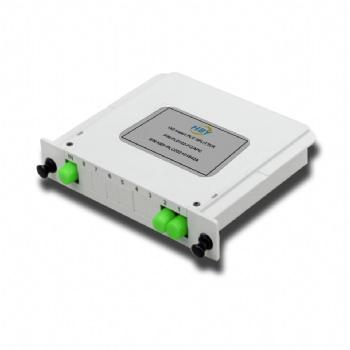Classification
The optical passive device can be classified according to its manufacturing process and the function.
Fiber optically passive device and integrated optical passive device according to the creation of
.
Press the functionality of
optical connection device, a light attenuation device, a light power distribution device, a light wavelength distribution device, an optical isolation device, an optical switch device, a light modulator, and the like.
Related Device
optical connector
classification
According to the structure, it can be divided into adjustment and non-adjustment [
can be divided into a coupled coupling and lens coupling;
can be divided into planar contact and spherical contact.
Among them, the most non-calorie docking coupling fiber optic active connector, such as a flat pair-in-form (Fc type), direct contact (PC type), and rectangular (SC type) fiber optic active connector.
Difference
Single-mode fiber optic cable active connector fiber optic cable is a single mode (fiber core diameter is φ9 μm), applied to single mode fiber optic cable system;
< P> Multimode fiber optic cable active connector fiber optic cable is multimode (fiber core diameter φ50 μm), applied to multimode fiber optic cable system;
data fiber optic cable activity connector fiber optic cable is data The fiber optic cable (the fiber core diameter is φ62.5 μm), applied to the data fiber optic cable system.
A light attenuator
The optical attenuator is a device that can attenuate a certain amount of attenuation of optical power.
The main type of optical attenuator
The main type of light attenuator is divided into: optical variable attenuator (continuous variable light attenuator, division Variable optical attenuator) and optical fixing attenuator
Small variable attenuator
small variable light attenuator attenuation range is 0 ~ 25dB . Mainly used for fiber optic communication system projects, fiber-optic data communication networks, etc., and continuously supported with the corresponding single-mode fiber activity.
Optocoupler
Optocoupler is a coupling region that enables optical signals in the transmission in a coupling region of a particular structure, and is redistributed.
Optocoupler Classification: Optical discrete component combination, fiber melt pull tapered, planar waveguide.
Fuse pull tapered full-optical coupling
The melt pull tapered coupler is a coating layer of two (or two or more) The fiber is closer to a certain manner, melting at high temperature heating, while stretching at both ends, ultimately a special waveguide structure of a double cone is formed in the heating zone, which can achieve a coupling of the transmission optical power.
Features: This coupler has a very low additional loss, good direction, good environment, simple and flexible control method, low production cost, suitable for mass production.
Wavelength division multiplexing / demultiplexer
Wavelength division multiplexing coupler is a coupler that is allocated in the coupling zone; The separation / demultiplexer is a light passive device that synthesizes the optical wave wavelength.
Classification: Medium film type wavelength division multiplexer, grating wavelength division multiplexer, waveguide raster type wavelength division multiplexer, fiber optic grating wave division multiplexer.
Optical isolator
The optical isolator is small in its working wavelength range, which is small to the forward transmission light, which is very large, which is a kind of transmission light loss. Transcourgeless light passive devices.
The main model
polarization correlation type and polarization independent type of the optical isolator can be divided into single-stage and double-level types. The optical isolator can be divided into online type and miniaturized according to the application.
Polarization-related optical isolator and polarization independent optical isolator
The former is highly dependent on the polarization state of the input light, suitable for laser and Other polarizers are used in combination; the latter is hardly affected by the input light flavor, suitable for use in fiber optic transmission systems.
Evaluation of optical passive device
Main technical indicators
Evaluation of light passive device main technical indicators include: insertion loss, reflection loss, work bandwidth, Withpaducting, power distribution errors, wavelength isolation, channel isolation, channel width, extinction ratio, switch speed, modulation speed, etc. Different devices require technical indicators for different properties. However, most of the optical passive devices require low insertion loss, high reflection loss, width of work bandwidth.
Reliability
Evaluation of the reliability of the optical passive device is based on the performance of the optical passive device at high temperature, low temperature, high and low temperature cycle, impact, vibration, high temperature aging, humidity, Changes in environmental conditions such as salt spray. Under the various environmental conditions required by the relevant standard, the smaller the optical technical indicators of the optical passive device, the higher the reliability.
